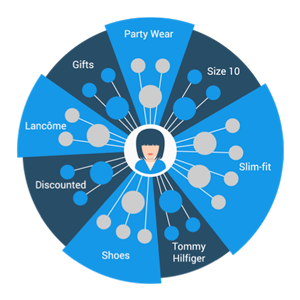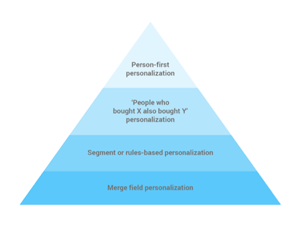Three Steps to Person-First Personalization
Person-first personalization is a hot topic at the moment. Forrester Research, The Relevancy Group, and other thought leaders are writing extensively on the subject. Why? Because consumers have raised their expectations. When consumers have personalized experiences with Spotify, Netflix or any other similar brand, they subsequently expect all other brands to deliver the same 'surprise and delight’ experience.
Person-first personalization is the process of creating systematic serendipity that is valuable and compelling to the consumer, with the primary objective being to drive sales and engagement. It can be used at all stages of the buying process — from passive subscribers at the top of the purchase funnel to active consumers already in the purchase funnel.
Person-first personalization is a step change for email marketing. As marketers, we have traditionally learned the importance of segmentation, but person-first personalization represents a move away from segmentation to individualized content.
Background
The traditional marketing automation platform works on email lists that marketers feed the platform. Traditionally, marketers segment consumers on a variety of criteria such as RFM, demographic and behavior. A person-first personalization system, however, goes way beyond that. Person-first personalization builds a profile of the tastes and interests of each consumer (including anonymous visitors). Data Scientists refer to this as an interest graph or a semantic profile. This interest graph provides marketers with a ranked understanding of the unique tastes of each consumer.
Delivering the step change
So how can marketers deliver on the promise of person-first personalization? Here are three strategies to set your organization up for success:
Step 1: Understand the consumer's tastes and interests


One consumer might quite like Tommy Hilfiger in preference to Calvin Klein, but prefers Prada to both. They may also like both denim and silk. They may like slim fit clothing for workwear, but loose jeans on weekends. Perhaps they have a party coming up in a few weeks and are looking for the perfect party shirt.
People's preferences do not fit into binary boxes — they have graded preferences that change over time and circumstance. As marketers, we need to recognize that preferences are not binary but graded, and we need to reconsider how we deal with the nuances of human preferences.
Step 2: Content readiness
In addition to a view of a consumer's preferences, the marketer must have the appropriate content at their fingertips. So, if the consumer is suddenly in the market to buy a party shirt, the marketer can immediately recommend a curated selection of the best party shirts that are based on that consumer's unique tastes and preferences.
Step 3: Surprise and delight at scale
In an era where 55% of product searches start on Amazon, retailers and e-commerce brands need to understand their consumers and be constantly ready to showcase products with a sense of serendipity. Serendipity is that particular moment of engagement when a consumer finds that exact party shirt, without effort, and without even thinking about it. She cannot believe her luck. Cool! she gushes. This type of systematic serendipity is the new way to boost revenue and engagement.
So, here’s my point: used correctly, person-first personalization can help you manufacture moments of serendipity at scale, and therefore help you raise revenue and engagement for your brand. Person-first personalization allows you to consistently 'surprise and delight' each consumer in real-time and across all channels.
Not just products - category ranking too
One of the highlights of person-first personalization is the ability to understand and cluster the tastes and preferences of each unique consumer. In turn, this allows you to rank not only products but also categories and promotions for each consumer. For example, many retailers will have hundreds of subcategories in their catalog. When you have millions of consumers, it is impossible to manually rank those subcategories for each consumer. Happily, person-first personalization allows you to automatically rank categories and products within those categories for each consumer.
Beware fake person first-personalization - what it is and what it isn't
As brands become increasingly aware of the benefits of person-based personalization, naturally many vendors are jumping on the bandwagon. When investigating person-first personalization, here are a few quick questions that will enable you to decide whether somebody is providing true person-first personalization capabilities:
- Specifically, how do you understand the tastes and interests of each consumer? Can your system build a clustered 'word cloud’ of the tastes and interests of each consumer? If so, do you just use metatags or can you use natural language too?
- Can you rank categories? We have more than 100 subcategories in our catalog but only wish to display a handful in each newsletter - how would you choose which categories to show each consumer in a newsletter?
- Can you automatically identify trending products? Moreover, rank those in the context of the consumer's identified tastes?
- We want to keep email content fresh. How do you use diversity models within the context of the consumer's identified tastes?
- Feedback loop: what feedback data does your system incorporate to update the personalization model?
- We have a small email team - how will this reduce campaign production times?
The personalization maturity roadmap
This maturity chart plots the four stages of email personalization and is intended to help marketers benchmark their email personalization and what they need to do to stay competitive.
Phase 1: Merge field personalization
This approach can be best for brands with limited data or for price-led campaigns where the objective is to get the product in front of as many people as possible. In this approach, personalization is limited to merge fields - for example Dear {firstname}.
Phase 2 Segment or rules-based personalization
In today's world, the vast majority of brands are using segmentation and business rules to identify customer segments. This phase involves segmentation based on RFM, behavior, or other data types, then sending campaigns to a defined audience.
Phase 3 ‘People who bought X also bought y’ personalization
 Product-to-product recommenders such as "people who bought X also bought Y" are a standard stepping stone for those looking to advance their personalization efforts. This can work well, but is based on a product-to-product correlation and therefore does not recognize the tastes of each particular recipient. Moreover, because this type of recommendation system relies on a product-to-product correlation, it has an inherently narrow view and can only provide recommendations on one product at a time. Personalization based on one datapoint can completely miss the mark.
Product-to-product recommenders such as "people who bought X also bought Y" are a standard stepping stone for those looking to advance their personalization efforts. This can work well, but is based on a product-to-product correlation and therefore does not recognize the tastes of each particular recipient. Moreover, because this type of recommendation system relies on a product-to-product correlation, it has an inherently narrow view and can only provide recommendations on one product at a time. Personalization based on one datapoint can completely miss the mark.
Phase 4: Person-first personalization
Person-first personalization starts with the understanding the tastes and interests of each consumer and using that data create truly personal experiences at scale. Preferably in real time.
Conclusion
The email profession has sometimes been accused of being ‘batch and blast’ practitioners, whereas many email marketers do recognize that person-first marketing can add real value to their business. Moreover, as a marketer, anything that can save you time and reduce campaign workload is a blessing. Person-first personalization, powered by Machine Learning, enables you to do this in a sophisticated, efficient and reliable way. Also, person-first personalization can strap a rocket to your email revenues, keep consumers coming back for more, and drive incremental improvements in all other channels.
If I could leave you with just one thought, it would be this: recognizing individual consumer's tastes and being able to 'surprise and delight' at scale will always pay dividends. That’s why the future of email marketing is brighter than ever before.

 How to resolve AdBlock issue?
How to resolve AdBlock issue? 